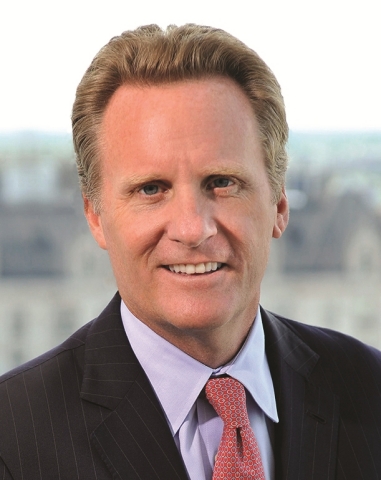PGIM expands ETF lineup to include two laddered funds of buffer ETFs
PGIM, the global investment management business of Prudential Financial, has launched two new laddered funds of buffer ETFs: the PGIM Laddered Fund of Buffer 12 ETF (BUFP) and the PGIM Laddered Fund of Buffer 20 ETF (PBFR). Offered at a 0.50% net expense ratio, these ETFs provide exposure to U.S. large-cap equity markets with downside protection and capped upside potential. BUFP targets equal investment in 12 PGIM U.S. Large-Cap Buffer 12 ETFs, while PBFR targets 12 PGIM U.S. Large-Cap Buffer 20 ETFs. The funds are designed to meet growing client demand for flexible, accessible, and efficient investment solutions.
- Launch of two new laddered funds of buffer ETFs: BUFP and PBFR.
- 0.50% net expense ratio, lowest-cost fund of buffer ETFs available.
- Provides U.S. large-cap equity market exposure with downside protection.
- Addresses growing client demand for flexible and accessible investment solutions.
- Targeted quarterly rebalancing to maintain equal weight in underlying ETFs.
- ETFs themselves do not provide any stated buffer against losses.
- Returns are by the caps of the Underlying Buffer ETFs.
- Potential upside due to the nature of the underlying buffer ETFs.
Insights
The introduction of the PGIM Laddered Fund of Buffer 12 ETF (BUFP) and the PGIM Laddered Fund of Buffer 20 ETF (PBFR) offers investors new low-cost avenues for capital appreciation with some downside protection, a significant move given the current market volatility. The 0.50% net expense ratio is relatively low, positioning these ETFs competitively in the market. However, it is essential to understand that while these ETFs provide limited downside protection, the upside potential is also capped, which may not appeal to more growth-oriented investors. The strategy aligns well with conservative investors looking to mitigate risks without foregoing equity market exposure entirely.
The critical takeaway is that these funds are optimized for a balance of protection and growth, ideal for those wary of market turbulence but still seeking participation in equity gains. Investors should weigh the cost benefits and the buffer limitations to see if they align with their individual risk tolerance and investment goals.
The addition of laddered buffer ETFs to PGIM's offerings reflects a growing trend in the ETF market towards defined outcome investments. This product launch caters to investor demand for simplified, one-ticker solutions that mitigate some of the operational complexities of individual buffer ETFs. The laddered nature of BUFP and PBFR, which reinvests into multiple underlying ETFs, allows for a smoother, more consistent investment strategy over time.
Such innovations are increasingly valuable in an environment where market unpredictability is a major concern. However, the inherent trade-off of capped returns is a limitation that investors must consider. The market's acceptance and success of these products will depend significantly on how well they communicate these trade-offs to potential investors. Additionally, the decision to sub-advise these ETFs to PGIM Quantitative Solutions, known for its expertise in quantitative strategies, enhances their appeal.
New ETFs offer one-stop solution for

Stuart Parker, President and CEO, PGIM Investments (Photo: Business Wire)
The two new ETFs seek to generate capital appreciation by providing investors with
BUFP targets an equal-weight investment in each of the 12 PGIM
“Laddered buffer ETFs are one of the fastest-growing segments of an already accelerating defined outcome ETF market — but flexibility and accessibility is critical in this space. We’ve seen strong client demand for both the underlying buffer ETFs as well as single-ticker solutions that can provide efficient exposure to this style of investing while reducing some of the operational load of investing in the individual monthly vintages,” said Stuart Parker, president and CEO of PGIM Investments.
With the launch of BUFP and PBFR, in addition to the accelerated rollout of the
“We are excited to be working alongside PGIM Investments to bring these new products to market and offer investors the ability to choose between individual monthly
Unlike the Underlying Buffer ETFs, the ETFs do not pursue a target outcome strategy. The buffer is only provided by the Underlying Buffer ETFs, and the ETFs themselves do not provide any stated buffer against losses. The ETFs likely will not receive the full benefit of the Underlying Buffer ETF buffers and could have limited upside potential. The ETFs’ returns are limited by the caps of the Underlying Buffer ETFs.
Learn more about PGIM’s suite of 40 ETFs which spans fixed income, equity, and multi-asset class solutions.
ABOUT PGIM INVESTMENTS
PGIM Investments LLC and its affiliates offer more than 100 funds globally across a broad spectrum of asset classes and investment styles. All products draw on PGIM’s globally diversified investment platform that encompasses the expertise of managers across fixed income, equities, alternatives and real estate.
ABOUT PGIM QUANTITATIVE SOLUTIONS
PGIM Quantitative Solutions is the quantitative equity, multi-asset and liquid alternatives specialist of PGIM. For more than 45 years, PGIM Quantitative Solutions has helped investors around the world solve their unique needs by leveraging the power of technology and data as well as advanced academic research. As of March 31, 2024, PGIM Quantitative Solutions managed
ABOUT PGIM
PGIM is the global asset management business of Prudential Financial, Inc. (PFI). PFI has a history that dates back over 145 years and through more than 30 market cycles. With 41 offices in 19 different countries (as of March 31, 2024), our more than 1,450 investment professionals are located in key financial centers around the world.
Our firm comprises multi-managers that collaborate with each other and specialize in a particular asset class with a focused investment approach. This gives our clients diversified solutions with global depth and scale across public and private asset classes, including fixed income, equities, real estate, private credit, and other alternatives. As a leading global asset manager with
For more information, visit pgim.com.
Prudential Financial, Inc. (PFI) of
1 The term PGIM as used in this announcement includes PGIM Investments LLC, an indirect, wholly owned subsidiary of Prudential Financial, Inc.
2 Source: Morningstar Direct as of May 31, 2024.
3 AUM totals shown include assets of PGIM Wadhwani LLP, which is a separate legal entity.
PGIM Laddered Fund Risks
The Funds are “funds of funds” and are subject to Underlying ETF and SPY risks, in that the value of an investment in the Funds will be related to the investment performance of the Underlying ETFs and, in turn, SPY. Therefore, the principal risks of investing in the Funds are closely related to the principal risks associated with the Underlying ETFs and its investments. Exposure to the Underlying ETFs will also expose the Funds to a pro rata portion of the Underlying ETFs’ fees and expenses. The fluctuating value of the FLEX Options will affect the Underlying ETFs’ value and, in turn, the Funds’ value. The Funds intend to generally rebalance its portfolio to equal weight (i.e., 8 1⁄
The Underlying ETFs invest in FLEX Options and, to the extent that the Underlying ETF writes or sells an option, if the decline or increase in the underlying asset is significantly below or above the exercise price of the written option, the Underlying ETF and, in turn, the Funds could experience a substantial or unlimited loss. FLEX Options are also subject to the risk that they may be less liquid than other securities, including standardized options as well as trading risks, as they are required to be centrally cleared, and valuation risks.
The Funds’ risks include, but are not limited to, target outcome period risk, where in the event the Funds acquire shares of an Underlying ETF after the first day of a Target Outcome Period or disposes of shares prior to the expiration of the Target Outcome Period, the value of the Funds’ investment in Underlying ETF shares may not be buffered against a decline in the value of SPY and may not participate in a gain in the value of SPY for the Funds’ investment period; buffered loss risk, in which there can be no guarantee that the Underlying ETFs will be successful in its strategy to provide downside protection against losses; cap change risk in which a new cap for an Underlying ETF is established at the beginning of each Target Outcome Period and is dependent on prevailing market conditions and is unlikely to remain the same for consecutive Target Outcome Periods; and capped upside risk, in that, since the Funds will acquire shares of the Underlying ETFs in connection with creations of new shares of the Funds and during each quarterly rebalance, the Funds typically will not acquire Underlying ETF shares on the first day of a Target Outcome Period. In the event that the Funds acquire Underlying ETF shares after the first day of a Target Outcome Period and the Underlying ETF has risen in value to a level near or at the cap, there may be little or no ability for the Funds to experience an investment gain on those Underlying ETF shares; however, the Funds will remain vulnerable to downside risks.
As actively managed ETFs, the Funds are subject to risks involved with: ETF shares trading risk (including the risk of the shares trading at a premium or discount to net asset value or the lack of an active trading market); authorized participant concentration risk; and the risk of transacting in cash versus in-kind. The Funds are subject to market risks, including economic risks, as well as market disruption and geopolitical risks (the value of investments may decrease, and international conflicts and geopolitical developments may adversely affect the
As a new and relatively small fund, the Funds’ performance may not represent how the Funds are expected to or may perform in the long term. Large shareholders could subject the Funds to large-scale redemption risk. Your actual cost of investing in the Funds may be higher than the expenses shown in the expense table for a variety of reasons. There is no guarantee the Funds’ objectives will be achieved. The risks associated with the Funds are more fully explained in the Funds’ prospectus and summary prospectus.
Consider a fund’s investment objectives, risks, charges and expenses carefully before investing. The prospectus and summary prospectus contain this and other information about the fund. Contact your financial professional for a prospectus and summary prospectus. Read them carefully before investing.
Investing in exchange traded funds (ETFs) involves risks. Some ETFs have more risk than others. The investment return and principal value will fluctuate, and shares when sold may be worth more or less than the original cost, and it is possible to lose money.
The Funds are actively managed ETFs and thus do not seek to replicate the performance of a specified index. ETF shares are not individually redeemable from the Funds. Shares may only be redeemed directly from the Fund by Authorized Participants in Creation Units.
Investment products are distributed by Prudential Investment Management Services LLC, member FINRA and SIPC. PGIM Quantitative Solutions is a wholly owned subsidiary of PGIM. © 2024 Prudential Financial, Inc. and its related entities. PGIM, PGIM Quantitative Solutions, and the PGIM logo are service marks of Prudential Financial, Inc. and its related entities, registered in many jurisdictions worldwide.
Investment products are not insured by the FDIC or any federal government agency, may lose value, and are not a deposit of or guaranteed by any bank or any bank affiliate.
1080778-00001-00
View source version on businesswire.com: https://www.businesswire.com/news/home/20240613523196/en/
MEDIA
Kylie Scott
+1 973 902 2503
kylie.scott@pgim.com
Source: PGIM







